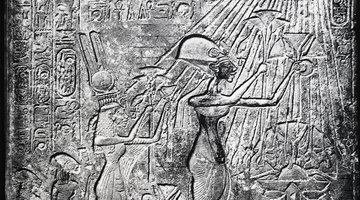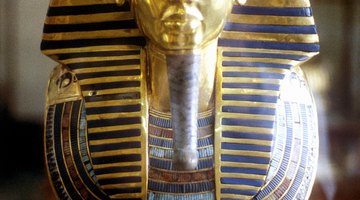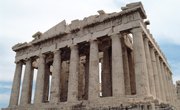King Tutankhamun, a pharaoh in the Eighteenth Dynasty in ancient Egypt, lived from 1341 BCE to 1323 BCE. Tutankhamun became king at the age of nine upon the death of his father Akhenaten. Akhenaten’s abolition of Egypt’s polytheistic religion and his focus upon one god, the sun god Aten, drastically changed Egypt’s religious traditions. During his reign, Tutankhamun and his regents began to return ancient Egyptian religious traditions back to their pre-Akhenaten norms.
Akhenaten's Religious Turmoil

Akhenaten’s monotheistic religion affected all aspects of daily life. The abolition of the old gods resulted in the closure of temples that had been around for centuries, which caused priests and priestesses to effectively become unemployed. Akhenaten moved the capitol city from Memphis to the virgin ground of Akhetaten, modern Amarna, and dedicated the city to the god Aten. Religious ceremonies and prayers were changed and focused solely on Aten; the famous “The Great Hymn to the Aten” is an example of a religious text from this period. One of the most noteworthy changes Akhenaten implemented was in art: He abolished the traditional canon of proportions for human figures in Egyptian art, which had been standard for well over one thousand years, and instead had himself and his family depicted in gross exaggeration, with elongated heads, necks, pouchy stomachs and spindly arms and legs. The changes Akhenaten wrought had turned Egypt's stable, traditional society upside down.
Tutankhamun's Decrees
Akhenaten’s sudden death left a young Tutankhamun head of state for an Egypt that was in shatters. Working with regents, one of Tutankhamun’s first acts was to restore the polytheistic religion. Citizens gradually moved back to Memphis and abandoned Amarna. Tutankhamun chronicled his changes back to normalcy in his Restoration Stele, where he attributed the chaos of his father's reign to abandonment by the gods. Tutankhamun spent his brief reign restoring society back to normal.
Religious Practices
Restoration of the old gods and goddesses allowed Tutankhamun to reopen temples and return priests and priestesses to their religious duties. Tutankhamun rebuilt temples, which had fallen into severe disrepair during his father's reign. He also replenished the depleted temple treasuries. Citizens of Egypt were no longer forced to worship a god they did not believe in, but rather, were free to worship the wide array of traditional Egyptian gods in temples and their residences.
Religious Art
Art in ancient Egypt was a powerful tool for propaganda, and kings used art to convey information about their rule. Religious art in King Tutankhamun’s reign resorted back to traditional artistic standards; gone were the severe human figures seen in the Amarna era. Religious artwork depicted the polytheistic gods and goddesses. In their restoration, temples received new statuary, wall paintings and relief carvings.
Related Articles
References
- The Rise and Fall of Ancient Egypt; by Toby Wilkinson; 2010
- The British Broadcasting Corporation: Akhenaten and the Amarna Period
- Tour Egypt: The Great Hymn to the Aten
- The British Broadcasting Corporation: Tutankhamun
- The Field Museum: Tutankhamun and the Golden Age of the Pharaohs--Religion in Tut's Time
Writer Bio
Natalie Chardonnet began writing in 2006, specializing in art, history, museums and travel. In 2010, she presented a paper on those subjects at the National Conference of Undergraduate Research. Chardonnet has a Bachelor of Arts in art history and a minor in Italian studies from Truman State University, in addition to a certificate in French from Ifalpes University in Chambery, France.











